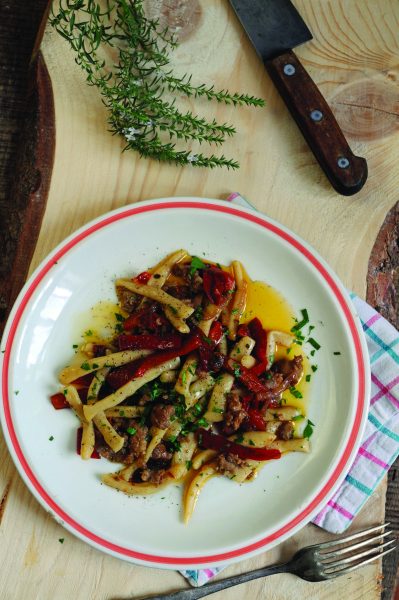In this instalment of our Make It Simple series, resident chef Mario Matassa shows us how to make an iconic Italian pasta.

Strozzapreti… literally ‘priest stranglers’, is one of the most antique pastas, with origins most certainly in Italian cucina povera. There are several entertaining legends that explain the name. One has it that it derives from gluttonous priests who ate too much too quickly and choked as a result. Another, that poor local housewives, exasperated by the wealth of their clergymen, made a coarse pasta that would choke them. It’s common in the Romagna and Marche regions and most certainly has links with the similarly named strangolapreti from Naples (which has its own equally entertaining stories of origin). Whatever the truth, it’s the most basic of pastas, made simply from flour and water, with the addition of a little salt and oil. Certain recipes include the addition of potatoes or eggs, but the general idea is the same.
Once formed, the pasta can be cooked directly or dried as with any flour and water pasta common to the south. What stands this pasta apart from the egg and flour combination ubiquitous in Emilia-Romagna is the texture of the finished product: it’s coarser and has a chewier texture. Yet the tubed form holds a sauce wonderfully and it works well with any variety of flavours.
Working by eye and hand
As I hail from the south of Italy, strozzapreti was a family favourite. It was a dish very easily and quickly prepared. My grandmother never weighed the ingredients, preferring to work by eye and hand. She used a combination of plain flour and semolina, adding water as was required. The trick is to arrive at the point where you have a malleable dough, not too wet nor too dry. Then, once rolled and formed, treat as a normal pasta. Add to vigorously boiling salted water and cook for approximately five minutes. The pasta will remain firm and chewy. Then simply spoon directly into your sauce of choice. Toss and serve.
Strozzapreti
Strozzapreti
SERVES: 4
PREPARATION: 30 minutes plus resting time
COOKING: 5 minutes
- 250g plain flour
- 250g semolina flour
- 250ml tepid water
- 4 tbsp extra-virgin olive oil
- 1 tsp salt
Recipe:
1 Mix the flours and salt in a mound on a large wooden surface. Make a well in the centre of the mound of dry ingredients.
2 Slowly drizzle the olive oil into the well in the centre of the mound, trying not to let it splash outside the edges.
3 Slowly pour the water into the centre of the mound and, with your fingers, begin to amalgamate the flours. Work around the circle.
4 Once you’ve added all the water, use a dough cutter to gently bring all the ingredients together into a rough ball of dough.
5 Knead the dough as you would a bread dough. If it feels too dry, add a tablespoon of water. If too wet, sprinkle some flour. But the dough should feel a little dry.
6 Knead for approximately 4 minutes and form a ball. Cover the dough with clingfilm and allow to rest in an ambient temperature for about 30 minutes.
7 Roll the dough into a thick log and cut into even pieces. Using your hands, roll the dough into 1.5cm thick snakes, just as you would gnocchi.
8 Line up the logs parallel and, using a dough cutter, cut into 7 to 8cm pieces. You don’t have to be too precise.
9 Using the dough scraper, gently press into the dough and roll it towards you to form a tube. Dust with flour and cook in boiling salted water.
